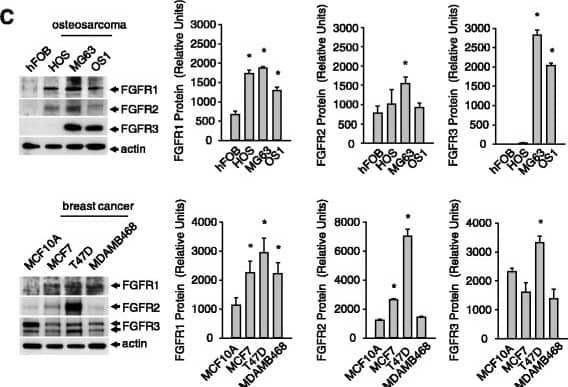Human FGFR1 (IIIb) Antibody Summary
Applications
Please Note: Optimal dilutions should be determined by each laboratory for each application. General Protocols are available in the Technical Information section on our website.
Scientific Data
 View Larger
View Larger
FGF R1 alpha Inhibition of FGF acidic-dependent Cell Proliferation and Neutralization by Human FGF R1 Antibody. Recombinant Human FGF R1a (IIIb) Fc Chimera (Catalog # 655-FR) inhibits Recombinant Human FGF acidic (Catalog # 232-FA) induced proliferation in the NR6R‑3T3 mouse fibroblast cell line in a dose-dependent manner (orange line). Inhibition of Recombinant Human FGF acidic (0.3 ng/mL) activity elicited by Recombinant Human FGF R1a (IIIb) Fc Chimera (6 ng/mL) is neutralized (green line) by increasing concentrations of Human FGF R1 (IIIb) Monoclonal Antibody (Catalog # MAB765). The ND50 is typically 0.075-0.3 µg/mL in the presence of heparin (10 µg/mL).
 View Larger
View Larger
Detection of Human FGFR1 by Immunocytochemistry/Immunofluorescence Proximity between AcSDKP and FGFR1 inhibits the TGF beta /smad signaling pathway in HMVECs. (a) HMVECs were treated with N-FGFR1 (1.5 μg/ml) for 48 h with or without preincubation with AcSDKP (100 nM) for 2 h, and the proximity between AcSDKP and FGFR1 was analyzed by the Duolink In Situ Assay. For each slide, images at a × 400 original magnification were obtained from six different areas. (b and c) HMVECs were treated with TGF beta 2 (5 ng/ml) for 15 min or 48 h with or without preincubation with AcSDKP for 2 h, and the p-smad3, TGF beta R1, TGF beta R2 and FGFR1 levels were analyzed by western blot. Densitometric analysis of the p-smad3/smad3, TGF beta R1/ beta -actin, TGF beta R2/ beta -actin and FGFR1/ beta -actin levels from each group (n=6) were analyzed. (d and e) HMVECs were incubated with TGF beta 2 for 15 min or 48 h with or without preincubation with AcSDKP or its mutants (AcDSPK, AcSDKA, AcADKP) (100 nM) for 2 h. The p-smad3/smad3, TGF beta R1/ beta -actin, TGF beta R2/ beta -actin and FGFR1/ beta -actin protein levels were analyzed by western blot Image collected and cropped by CiteAb from the following publication (https://pubmed.ncbi.nlm.nih.gov/28771231), licensed under a CC-BY license. Not internally tested by R&D Systems.
 View Larger
View Larger
Detection of Human FGFR1 by Western Blot Expression of FGFR1 in cells from breast and bone tissue. a, FGFR mRNA transcript levels in normal and cancer cells. b, Fold change in FGFR mRNA based on expression in cancers cells relative to normal cells. c, FGFR protein levels in normal versus cancer cells. Results are from triplicate experiments and the Western blot is representative of the triplicates. (*p < 0.05) Image collected and cropped by CiteAb from the following open publication (https://pubmed.ncbi.nlm.nih.gov/26201468), licensed under a CC-BY license. Not internally tested by R&D Systems.
Reconstitution Calculator
Preparation and Storage
- 12 months from date of receipt, -20 to -70 °C as supplied.
- 1 month, 2 to 8 °C under sterile conditions after reconstitution.
- 6 months, -20 to -70 °C under sterile conditions after reconstitution.
Background: FGFR1
FGF R1 occurs as multiple isoforms. The extracellular domain consists of three ( alpha isoforms) or two ( beta isoforms) immunoglobulin-like domains. In addition, the membrane-proximal Ig-like domain can be encoded by alternative exons yielding (IIIb) or (IIIc) isoforms.
Product Datasheets
Citations for Human FGFR1 (IIIb) Antibody
R&D Systems personnel manually curate a database that contains references using R&D Systems products. The data collected includes not only links to publications in PubMed, but also provides information about sample types, species, and experimental conditions.
8
Citations: Showing 1 - 8
Filter your results:
Filter by:
-
Beta klotho is essential for the anti-endothelial mesenchymal transition effects of N-acetyl-seryl-aspartyl-lysyl-proline
Authors: Gao R, Kanasaki K, Li J et al.
FEBS Open Bio.
-
Fibroblast growth factor receptor is a mechanistic link between visceral adiposity and cancer
Authors: D Chakrabort, V Benham, B Bullard, T Kearney, HC Hsia, D Gibbon, EY Demireva, SY Lunt, JJ Bernard
Oncogene, 2017-08-07;36(48):6668-6679.
-
FGFR1 is critical for the anti-endothelial mesenchymal transition effect of N-acetyl-seryl-aspartyl-lysyl-proline via induction of the MAP4K4 pathway.
Authors: Li J, Shi S, et al.
Cell Death Dis
-
Tissue transglutaminase promotes PDGF/PDGFR-mediated signaling and responses in vascular smooth muscle cells
Authors: Evgeny A. Zemskov, Irina Mikhailenko, Elizabeth P. Smith, Alexey M. Belkin
Journal of Cellular Physiology
-
Fibroblast growth factor-2 maintains a niche-dependent population of self-renewing highly potent non-adherent mesenchymal progenitors through FGFR2c.
Authors: Di Maggio N, Mehrkens A, Papadimitropoulos A, Schaeren S, Heberer M, Banfi A, Martin I
Stem Cells, 2012-07-01;30(7):1455-64.
Species: Human
Sample Types: Whole Cells
Applications: Neutralization -
Regulation of platelet-derived growth factor receptor function by integrin-associated cell surface transglutaminase.
Authors: Zemskov EA, Loukinova E, Mikhailenko I, Coleman RA, Strickland DK, Belkin AM
J. Biol. Chem., 2009-04-22;284(24):16693-703.
Species: Human
Sample Types: Whole Cells
Applications: Bioassay -
The Interaction of Apelin and FGFR1 Ameliorated the Kidney Fibrosis through Suppression of TGFbeta-Induced Endothelial-to-Mesenchymal Transition
Authors: R Gao, Y Wu, Q Yang, L Chen, J Chen, B Wang, Z Liu, J Jin, J Li, G Wu
Oxidative Medicine and Cellular Longevity, 2023-02-04;2023(0):5012474.
-
Targeting the heparin-binding domain of fibroblast growth factor receptor 1 as a potential cancer therapy
Authors: Ling Ling, Si Kee Tan, Ting Hwee Goh, Edwin Cheung, Victor Nurcombe, Andre J. van Wijnen et al.
Molecular Cancer
FAQs
-
Why is heparin necessary in the neutralization assay using Human FGFR1 (IIIb) Antibody, Catalog # MAB765?
The heparin is a necessary cofactor for the binding of FGF to the receptor which induces the proliferation that this antibody neutralizes.
Reviews for Human FGFR1 (IIIb) Antibody
There are currently no reviews for this product. Be the first to review Human FGFR1 (IIIb) Antibody and earn rewards!
Have you used Human FGFR1 (IIIb) Antibody?
Submit a review and receive an Amazon gift card.
$25/€18/£15/$25CAN/¥75 Yuan/¥2500 Yen for a review with an image
$10/€7/£6/$10 CAD/¥70 Yuan/¥1110 Yen for a review without an image


